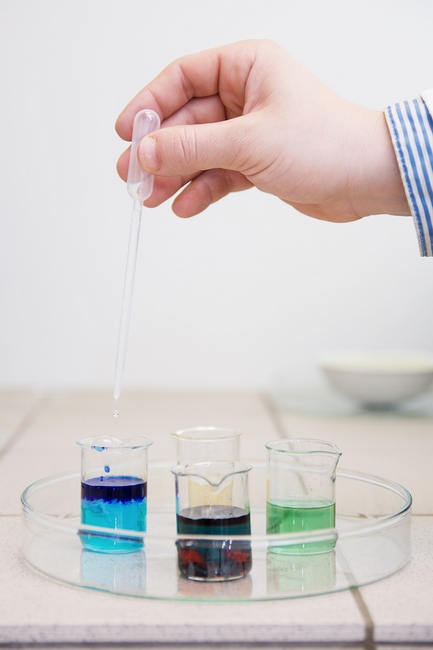Laboratory of synthesis and chemical analysis
The laboratory of synthesis and chemical analysis is dedicated to the preparation of new materials and development of novel synthetic methods for nanoparticles and nanostructured composites. Moreover, it is also a main source of materials studied within the Department of Magnetics and Superconductors. All relevant chemical analyses of studied samples are provided here as well.
Molten salt synthesis
Magnetic nanoparticles based on manganites of the general composition Ln1-xAexMnO3, where Ln stands for a rare earth metal and Ae for an alkali earth metal, are prepared here by the so-called molten salt synthesis, i.e., by growth of nanoparticles in flux of alkali metal nitrites or nitrates. In contrast to traditional sol-gel procedures, highly dispersed nanoparticles of better defined shape and relatively narrow size distribution are obtained. The resulting nanoparticles are not grown together and do not form sintering bridges that originate in sol-gel products due to the final thermal treatment of a solid precursor. Therefore, mechanical processing of the as-synthesized nanoparticles is not necessary. Moreover, the synthesis in an agitated flux provides homogeneity of the reaction mixture and it enables growth of nanoparticles in an isotropic environment.

Fig. 1. Synthesis of La1-xSrxMnO3 nanoparticles in flux of NaNO2. The synthesis is terminated by pulling the crucible of the furnace (a) and quick cooling of the flux (b). Transmission electron micrograph shows the so-obtained La0.63Sr0.37MnO3 nanoparticles.
Synthesis of nanoparticles by thermal decomposition of organic metal complexes
Controlled thermal decomposition of organic metal complexes is an advanced method for the synthesis of oxide nanoparticles, namely nanoparticles of spinel phases (e.g. doped magnetite and ferrites) as well as manganese oxides, etc. Nanoparticles originate from the decomposition of suitable precursors (e.g. metal acetylacetonates or oleates) at the presence of surfactants (oleic acid, oleylamine, hexadecane-1,2-diol) in high-boiling solvents (octadecene or dibenzylether). The precise control of reaction conditions enables to prepare monodisperse and highly crystalline nanoparticles with the size of 5-25 nm. Importantly, ferrite nanoparticles prepared by this method exhibit bulk-like magnetic properties.

Fig. 2. Synthesis of monodisperse nanoparticles of zinc-doped magnetite by thermal decomposition of acetylacetonates in octadecene under the presence of oleic acid, oleylamine, and hexadecane-1,2-diol. The reaction is carried out under strictly inert and anhydrous conditions at temperatures of 200 °C to 300 °C (a). The transmission electron micrograph shows Zn0.33Fe2.67O4 with the size of 15 nm prepared by this method (b).
Hydrothermal synthesis
A pressure vessel DAB-2 (Berghof) with exchangeable teflon inserts, allowing hydrothermal synthesis at temperatures up to 250 °C and pressures up to 200 bar, is at our disposal. The synthesis is carried out in a heating chamber which prevents any temperature gradients, while homogeneity of the reaction mixture is achieved by magnetic stirring. We employ hydrothermal synthesis for preparation of magnetic nanoparticles based on iron and manganese oxides (e.g. ferrites of the general composition Mn1-xZnxFe2O4 a Co1-xZnxFe2O4). Smaller nanoparticles can be prepared either by surfactant-assisted procedure, as surfactants efficiently suppress the crystal growth, or by suitable choice of reaction conditions.

Fig. 3. Hydrothermal synthesis: the pressure vessel in the heating chamber with (a) and nanocrystalline La1-xSrxMnO3 phase prepared under strongly alkaline conditions at the temperature of 240 °C (b).
Sol-gel routes
We usually employ sol-gel procedures, e.g., the citrate method (Pechini process) for synthesis of both nanocrystalline and bulk samples of various oxides (perovskite manganites, cobaltites, layer structures NaxCoO2, etc.). Such preparation is based on the gradual transition of a solution to a homogenous gel with high content of organic components. Then the gel is dried, thermally decomposed, and thus a reactive mixture of fine particles is formed. By using this precursor, single phase oxides can be achieved through annealing at relatively low temperatures which allows to prepare even nanocrystalline phases. However, further mechanical processing of such raw nanocrystalline products is inevitable to obtain individual nanoparticles that can be dispersed.

Fig. 4. Preparation of nanoparticles via sol-gel methods: a precursor obtained by the sol-gel process has to be treated by annealing in furnace (a, b). Transmission electron micrographs show the as-grown nanocrystalline phase with sintering bridges between the nanoparticles (c) and the final product obtained by rolling and milling (d).
Coprecipitation, ceramic method, and thermal processing
Some samples, e.g., larger nanoparticles of Co-Zn ferrites are prepared by the coprecipitation method and subsequent thermal treatment. Further, we also use the traditional ceramic route to prepare large amounts of bulk samples of certain oxides.

Fig. 5. Coprecipitation procedures are based on precipitation of cations from their aqueous solution upon adjustment of pH.
Our laboratory is equipped with various furnaces that enable thermal annealing at temperatures up to 1600 °C in different atmospheres (inert gas, oxygen, atmospheres with a controlled partial pressure of oxygen).

Fig. 6. Thermal treatment in furnaces with controlled atmosphere: the horizontal furnaces enable annealing at temperatures up to 1200 °C in various atmospheres
Coating of nanoparticles with silica, titania, hybrid organically modified silica, and other materials
Often, we perform coating of magnetic nanoparticles with silica (amorphous hydrated silicon dioxide), eventually by hybrid organically modified silica layers that enable further organic functionalization. These procedures are based on suitable stabilization of magnetic cores followed by deposition of silica shell that originates through the hydrolysis of tetetraethoxysilane, eventually other alkoxysilanes, and subsequent polycondensation of silicic species. Recently, we have developed a new procedure for efficient coating of nanoparticles by amorphous titania which forms a continuous shell around magnetic cores.

Fig. 7. Encapsulation of magnetic cores by means of hydrolysis and polycodnensation of tetraethoxysilane, alternatively in mixture with other alkoxysilanes including complex fluorescent precursors (a). Transmission electron micrographs of La0.63Sr0.37MnO3 nanoparticles coated with a two-ply silica shell (b): the first layer is covalently functionalized with rhodamine B and covered by the protective second layer of pure silica. The other micrographs show Zn0.33Fe2.67O4 nanoparticles coated with silica by the reverse microemulsion method (c) and La0.75Sr0.25MnO3 nanoparticles coated with amorphous titania (d).
Decoration and synthesis of gold nanoshells
Further, preparation of ultrafine gold nanoparticles is carried out in our laboratory. The gold nanoparticles are used for the decoration of various surfaces and mainly for decoration of larger silica-coated particles. In particular, magnetic cores coated with primary silica shell and further decorated with gold nanoparticles are prepared. These complex particles are used for examples as intermediate products in the preparation of continuous gold nanoshells that are, eventually, further organically functionalized (e.g. by thiolated cyclodextrins for specific analytical applications).

Fig. 8. Synthesis of complex magnetic nanoparticles with gold nanostructures. The first transmission electron micrograph shows silica-coated nanoparticles of Co-Zn ferrite that were decorated with fine gold nanoparticles with size of 2-3 nm (a). The second micrograph shows the same particles after synthesis of a nearly continuous gold nanoshell (b).
Organic synthesis and organic functionalization
The development of complex magnetic nanoparticles for applications in biological research and medicine belongs to important topics of our laboratory. Thus, we perform also organic synthesis and preparative chromatography to prepare and purify various organic compounds for specific functionalization of nanoparticles. For illustration, the synthesis of various fluorescent silanes or complex molecules wit mPEG/PEG (methoxypoly(ethylene glycole)/poly(ethylene glycole)) chains is carried out. The latter compounds are used for the synthesis of organic corona on silica-coated magnetic particles.

Fig. 9. Scheme describing the synthesis of a complex fluorescent silane derived from rhodamine B. In the first step, the amid is prepared from rhodamine B and piperazine in an excess of the amine by virtue of N,N'-dicyclohexylcarbodiimide, 4-dimethylaminopyridine, a N-hydroxysuccinimide. The resulting monoamide is isolated by column chromatography. In the second step, the alkylation is carried out by 3-iodopropyltrimethoxysilane using K2CO3 as a base.
Mechanical processing of samples
Certain samples of nanoparticles are obtained by mechanical treatment of nanocrystalline phases that were prepared by sol-gel or coprecipitation procedures. Our laboratory is equipped with a rolling machine and a mixer mill both of which are used for this purpose. In contrast, well-sintered bulk samples are achieved by isostatic cold pressing followed by thermal treatment. The sintered products are usually cut by a diamond wire saw to get final samples for various measurements, eventually the samples are also polished before certain analysis (e.g. scanning electron microscopy).

Fig. 10. Mechanical processing. Nanocrystalline phases prepared by annealing are subjected to rolling (a), whereby sintering bridges are broken. Compact samples intended for measurements of transport properties are cut from sintered products by using a diamond wire saw (b).
Chemical analysis
Classic chemical analysis is carried out in our laboratory to determine the content of metals in starting materials, which enables to prepare products with an accurate chemical composition. The analysis of macrocomponents is performed via titrations (chelatometry) or via gravimetry (e.g. the determination of strontium). We also analyse the actual oxygen stoichiometry of perovskite manganites by a reverse redox titration (cerimetry). Further, the chemical analysis of dilute suspensions of various nanoparticles (silica-coated manganites, ferrites, etc.) is crucial for our studies as well. Concentration of a suspension is precisely determined after mineral decomposition of the sample via atomic absorption spectroscopy (in cooperation with another laboratory).

Fig. 11. Laboratory dedicated to chemical analysis. Mineral decomposition of samples intended for the determination of macrocomponents (titrations and gravimetry) or for chemical analysis of dilute metals (atomic absorption spectroscopy) are carried out on heating plates. The burner, condenser, and bubblers are used during the sample preparation for the determination of oxygen stoichiometry. A typical example of chemical analysis is the chelatometric determination of zinc with xylenol orange, which provides a clear indication of the equivalence point (see the titration flasks).
Contact person: Ondřej Kaman

